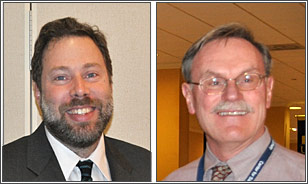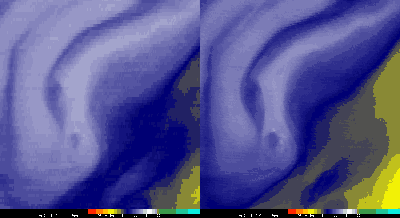Hillger and Schmit Win Department of Commerce Silver Medal
for GOES Science Test Work
 18 August 2011 -
Earlier this month the Department of Commerce
announced their 2011 Gold & Silver Medal winners. We congratulate Don Hillger and Tim
Schmit of STAR's Cooperative Research Program, who were
awarded NESDIS' only 2011 silver medal for their outstanding work
'revolutionizing' the NOAA Science Tests for Geostationary Satellites. As
a consequence of their efforts, the time to activate one of the
'backup' GOES satellites already in orbit was reduced from 4-7 weeks to
less than 24 hours, an improvement whose dollar value is conservatively
estimated at $5-10 million. 18 August 2011 -
Earlier this month the Department of Commerce
announced their 2011 Gold & Silver Medal winners. We congratulate Don Hillger and Tim
Schmit of STAR's Cooperative Research Program, who were
awarded NESDIS' only 2011 silver medal for their outstanding work
'revolutionizing' the NOAA Science Tests for Geostationary Satellites. As
a consequence of their efforts, the time to activate one of the
'backup' GOES satellites already in orbit was reduced from 4-7 weeks to
less than 24 hours, an improvement whose dollar value is conservatively
estimated at $5-10 million.
GOES-11 versus GOES-14 Imager "water vapor" image;
Note the finer spatial resolutions of the GOES-14 image

Additionally, Hillger and Schmit's work diminishes the
likelihood that the United States would ever be without
an operational GOES satellite. Max Mayfield, former director of the
National Hurricane Center, says "One of my fears while serving as NHC
Director was the possible loss of a GOES satellite. It is comforting to
know that we now have backup GOES satellites already launched and
currently in storage. These satellites in storage need to be
operational as soon as possible after one of the current satellites
fails. Test procedures to reduce the time to make the imager, sounder
and derived products operational are critical. One can only imagine
what could happen if, for example, a major hurricane were threatening
the U.S. and no GOES data were available."
As Schmit stated, "It takes a large and diverse team to check out these
satellites. We had lots of help from NASA, NOAA cooperative institutes,
other parts of NESDIS, data centers, contractors, and other parts of NOAA,
etc. I think the NOAA science tests that check-out the GOES are a great
example of the three pillar partnership in action: Government, Industry
and Universities. Each group brings a unique strength -- no two groups
alone could successfully accomplish the tasks!".
STAR congratulates Hillger and Schmit and the entire team who participated in
this highly successful and valuable effort.
|

